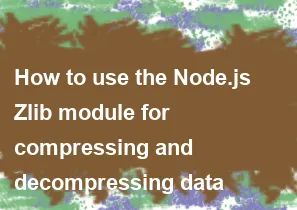How to use the Node.js Zlib module for compressing and decompressing data

The zlib module in Node.js provides functionality for compressing and decompressing data using various algorithms, such as Gzip and Deflate. Here's a basic guide on how to use the zlib module for compressing and decompressing data:
Compressing Data:
javascriptconst zlib = require('zlib');
const fs = require('fs');
const inputFilePath = 'input.txt';
const outputFilePath = 'output.gz';
// Create a readable stream from the input file
const readStream = fs.createReadStream(inputFilePath);
// Create a writable stream to the output file, applying gzip compression
const writeStream = fs.createWriteStream(outputFilePath);
const gzip = zlib.createGzip();
// Pipe the input stream through the gzip transformation and then to the output stream
readStream.pipe(gzip).pipe(writeStream);
// Event handlers
readStream.on('close', () => console.log('Read stream closed.'));
writeStream.on('finish', () => console.log('Write stream finished.'));
In this example, input.txt is the file you want to compress, and the compressed output will be written to output.gz.
Decompressing Data:
javascriptconst zlib = require('zlib');
const fs = require('fs');
const compressedFilePath = 'output.gz';
const decompressedFilePath = 'decompressed.txt';
// Create a readable stream from the compressed file
const readStream = fs.createReadStream(compressedFilePath);
// Create a writable stream to the decompressed file
const writeStream = fs.createWriteStream(decompressedFilePath);
// Pipe the input stream through the gzip decompression and then to the output stream
const gunzip = zlib.createGunzip();
readStream.pipe(gunzip).pipe(writeStream);
// Event handlers
readStream.on('close', () => console.log('Read stream closed.'));
writeStream.on('finish', () => console.log('Write stream finished.'));
In this example, output.gz is the compressed file, and the decompressed output will be written to decompressed.txt.
These examples use streams to efficiently handle large files without loading the entire content into memory. Adjust the file paths and compression options as needed for your use case.
-
Popular Post
- How to optimize for Google's About This Result feature for local businesses
- How to implement multi-language support in an Express.js application
- How to handle and optimize for changes in mobile search behavior
- How to handle CORS in a Node.js application
- How to use Vue.js with a UI framework (e.g., Vuetify, Element UI)
- How to configure Laravel Telescope for monitoring and profiling API requests
- How to create a command-line tool using the Commander.js library in Node.js
- How to implement code splitting in a React.js application
- How to use the AWS SDK for Node.js to interact with various AWS services
- How to use the Node.js Stream API for efficient data processing
- How to implement a cookie parser middleware in Node.js
- How to implement WebSockets for real-time communication in React
-
Latest Post
- How to implement a dynamic form with dynamic field styling based on user input in Next.js
- How to create a custom hook for handling user interactions with the browser's device motion in Next.js
- How to create a custom hook for handling user interactions with the browser's battery status in Next.js
- How to implement a dynamic form with dynamic field visibility based on user input in Next.js
- How to implement a dynamic form with real-time collaboration features in Next.js
- How to create a custom hook for handling user interactions with the browser's media devices in Next.js
- How to use the useSWRInfinite hook for paginating data with a custom loading indicator in Next.js
- How to create a custom hook for handling user interactions with the browser's network status in Next.js
- How to create a custom hook for handling user interactions with the browser's location in Next.js
- How to implement a dynamic form with multi-language support in Next.js
- How to create a custom hook for handling user interactions with the browser's ambient light sensor in Next.js
- How to use the useHover hook for creating interactive image zoom effects in Next.js